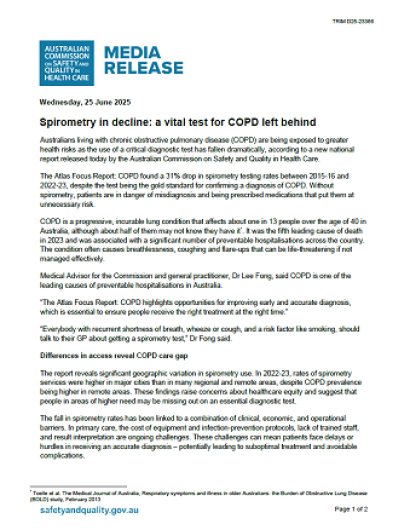The Atlas Focus Report: COPD found a 31% drop in spirometry testing rates between 2015-16 and 2022-23, despite the test being the gold standard for confirming a diagnosis of COPD. Without spirometry, patients are in danger of misdiagnosis and being prescribed medications that put them at unnecessary risk.
COPD is a progressive, incurable lung condition that affects about one in 13 people over the age of 40 in Australia, although about half of them may not know they have it[1]. It was the fifth leading cause of death in 2023 and was associated with a significant number of preventable hospitalisations across the country. The condition often causes breathlessness, coughing and flare-ups that can be life-threatening if not managed effectively.
Medical Advisor for the Commission and general practitioner, Dr Lee Fong, said COPD is one of the leading causes of preventable hospitalisations in Australia.
“The Atlas Focus Report: COPD highlights opportunities for improving early and accurate diagnosis, which is essential to ensure people receive the right treatment at the right time.”
“Everybody with recurrent shortness of breath, wheeze or cough, and a risk factor like smoking, should talk to their GP about getting a spirometry test,” Dr Fong said.
Differences in access reveal COPD care gap
The report reveals significant geographic variation in spirometry use. In 2022-23, rates of spirometry services were higher in major cities than in many regional and remote areas, despite COPD prevalence being higher in remote areas. These findings raise concerns about healthcare equity and suggest that people in areas of higher need may be missing out on an essential diagnostic test.
The fall in spirometry rates has been linked to a combination of clinical, economic, and operational barriers. In primary care, the cost of equipment and infection-prevention protocols, lack of trained staff, and result interpretation are ongoing challenges. These challenges can mean patients face delays or hurdles in receiving an accurate diagnosis – potentially leading to suboptimal treatment and avoidable complications.
Concern over rising triple-therapy use
The report also shows a 130% increase in the use of triple therapy – a combination of inhaled corticosteroids (ICS) with long-acting dual bronchodilators (LAMA and LABA) – despite guidelines recommending they be reserved for patients with severe COPD with frequent exacerbations and with significant symptoms despite optimal dual therapy; and for those with co-existing asthma. ICSs are a cornerstone of asthma treatment but are often much less useful and carry much higher risk for people with COPD – including the risk of pneumonia.
“We now have clear national data showing that spirometry use has plummeted, and triple therapy, which should be reserved for a select group of COPD patients, has had a substantial rise. We must refocus efforts to ensure people receive the right care, based on accurate diagnosis and best practice.”
“Patients with COPD who are using triple therapy should check with their GP or pharmacist if it’s still the best treatment for them. COPD guidelines recommend adapting therapy in response to symptoms and exacerbations,” Dr Fong said.
A roadmap to better care
The report complements the COPD Clinical Care Standard, released in October 2024, which outlines the expected components of evidence-based care for people with COPD. Together, these initiatives support general practitioners, health services and policymakers to identify areas for improvement and drive change across the healthcare system.
Interactive maps and regional data are available on the Commission’s website, enabling healthcare professionals and local health services to explore variations in care across Australia and take informed action to improve outcomes.
The Commission is calling on healthcare leaders, primary care providers and policymakers to review the findings and consider actions that improve access to spirometry, support appropriate prescribing and ensure equitable, high-quality care for people with COPD.
Access the Atlas Focus Report: COPD and download the Highlights Report: COPD
More information: safetyandquality.gov.au/Atlas-COPD

